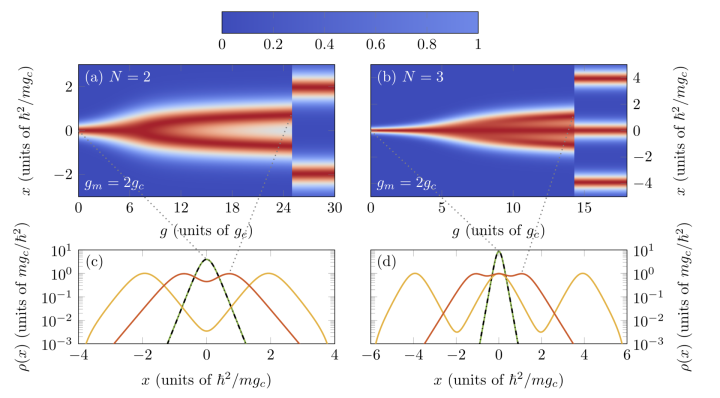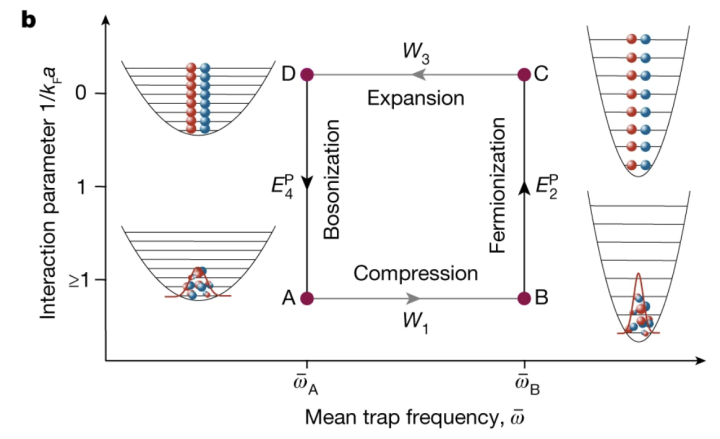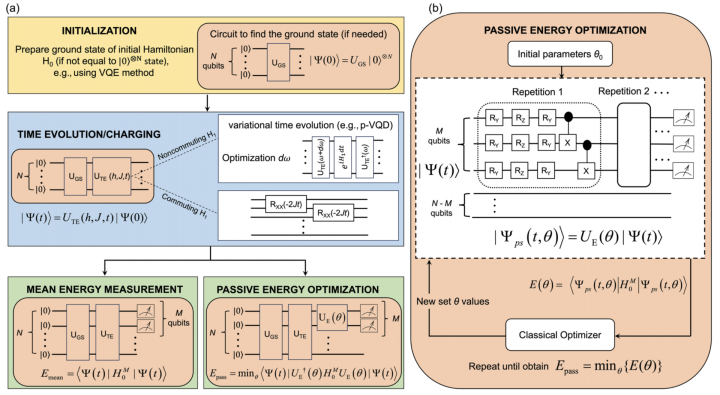Quantum Systems Unit
Professor Thomas Busch
Abstract
The past year saw some changes in the Quantum Systems Unit, with the PI also taking up the duties of the Dean of the Graduate School and therefore the Staff Scientist Dr. Thomas Fogarty taking on a larger role in leading and directing the research. Among the many projects we carried out this year, the collaboration with the experimental group of Prof. Widera on the Pauli engine stands out, as it conceived and also realised a fully quantum mechanical engine. We were able to show that such a device can be run with very high efficiencies, and the work attracted significant attention from the general public as well.
1. Staff
- Dr. Thomás Fogarty, Staff Scientist
- Dr. Hao Lyu, Postdoctoral Scholar
- Dr. Sayyare Aksu, Postdoctoral Scholar
- Dr. Kritika Jain, Postdoctoral Scholar
- Dr. Eloisa Cuestas, Postdoctoral Scholar
- Dr. Wenbin He, Postdoctoral Scholar
- Dr. Giedrius Žlabys, Postdoctoral Scholar
- Dr. Chinmayee Mishra, Postdoctoral Scholar
- Mr. Muhammad Sirajul Hasan, PhD Student
- Mr. Mohamed Boubakour, PhD Student
- Mr. Jose Carlos Pelayo, PhD Student
- Ms. Keerthy Menon, PhD Student
- Mr. Tai Tran, PhD Student
- Mr. Hoshu Hiyane, PhD Student
- Ms. Sarika Sasidharan Nair, PhD Student
- Mr. Raul Alejandro Hidalgo Sacoto, PhD Student
- Ms. Sawako Koki, Research Unit Administrator
Rotation Students
- Mr. Ilya Ryzov (September-December, 2023)
- Ms. Salome Catherine Hayes-Shuptar (January-April, 2024)
Research Interns
- Mr. Felipe Gomez Lozada, National University of Colombia, Colombia (SEP 25 - Mar 28)
- Ms. Nikola Mang, TU Dortmund University, Germany (Apr 19 - Jun 09)
- Mr. Duc Hoang, Ho Chi Minh City University of Education, Vietnam (Oct 20 - Jun 30)*FY2022/2023
2. Collaborations
2.1 Quantum thermodynamics
- Type of collaboration: Joint research
- Researchers:
- Prof. S. Campbell, University College Dublin, Ireland
- Prof. J. Goold. Trinity College Dublin, Ireland
2.2 Quantum engines
- Type of collaboration: Joint research
- Researchers:
- Prof. A. Widera, Rheinland-Pfälzische Technische Universität Kaiserslautern-Landau, Germany
- Prof. E. Lutz, University of Stuttgart, Germany
2.3 Shortcuts to Adiabaticity
- Type of collaboration: Joint research
- Researchers:
- Prof. X. Chen, University of the Basque Country Bilbao, Spain
- Prof. Y. Zhang. Shanghai University, China
- Prof. A. Ruschhaupt, University College Cork, Ireland
2.4 Strongly correlated few-particle systems
- Type of collaboration: Joint research
- Researchers:
- Prof. M.-A. Garcia-March, Universidad Politécnica de Valencia, Spain
2.5 Topological states in the AFKP
- Type of collaboration: Joint research
- Researchers:
- Prof. Tomoki Ozawa, Tohoku University, Japan
2.6 Atomic dynamics in nano-scale potentials
- Type of collaboration: Joint research
- Researchers:
- Prof. Gediminas Juzeliūnas, Vilnius University, Lithuania
2.7 Droplet-impurity interactions
- Type of collaboration: Joint research
- Researchers:
- Prof. Simeon Mistakidis, Missouri University of Science and Technology, US
3. Activities and Findings
3.1 Quantum chaos in interacting Bose-Bose mixtures
The appearance of chaotic quantum dynamics significantly depends on the symmetry properties of a system, and in cold atomic systems many of these can be experimentally controlled. In this work, we have systematically study the emergence of quantum chaos in a minimal system describing one-dimensional harmonically trapped Bose-Bose mixtures by tuning the particle-particle interactions. Using an improved exact diagonalization scheme, we have examined the transition from integrability to chaos when the inter-component interaction changes from weak to strong. Our study was based on the analysis of the level spacing distribution and the distribution of the matrix elements of observables in terms of the eigenstate thermalization hypothesis and their dynamics. We have shown that one can obtain strong signatures of chaos by increasing the inter-component interaction strength and breaking the symmetry of intra-component interactions.
Figure: The fitted Brody distribution parameter as a function of intra-component interaction strengths for three different values of the inter-component interaction strength.
Publication:
Quantum chaos in interacting Bose-Bose mixtures
T.D. Anh-Tai, M. Mikkelsen, Th. Busch, and T. Fogarty
SciPost Phys. 15, 048 (2023).
3.2 Fermionization of a few-body Bose system immersed into a Bose-Einstein condensate
We have studied the recently introduced self-pinning transition [Phys. Rev. Lett. 128, 053401 (2022)] in a quasi-one-dimensional two-component quantum gas in the case where the component immersed into the Bose-Einstein condensate has a finite intraspecies interaction strength. As a result of the matter-wave backaction, the fermionization in the limit of infinite intraspecies repulsion occurs via a first-order phase transition to the self-pinned state, which is in contrast to the asymptotic behavior in static trapping potentials. We were also able to show that the system exhibits an additional superfluid state for the immersed component if the interspecies interaction is able to overcome the intraspecies repulsion. We were able to approximate the superfluid state in an analytical model and derive an expression for the phase transition line that coincided with well-known phase separation criteria in binary Bose systems. The full phase diagram of the system was mapped out numerically for the case of two and three atoms in the immersed component.
Figure: Top row: Renormalized minority component density as a function of the intraspecies interaction strength g for a system of (a) N = 2 and (b) N = 3 particles at fixed interspecies interaction strength g and density. Bottom row: The corresponding line densities in the superfluid state at g = 0 (green lines) and right before the transition (red lines) are shown to scale in (c) and (d) respectively. The yellow lines show
the density in the pinned state.
Publication:
Fermionization of a few-body Bose system immersed into a Bose-Einstein condensate
T. Keller, T. Fogarty, and Th. Busch
SciPost Phys. 15, 095 (2023).
3.3 A quantum engine in the BEC–BCS crossover
Heat engines convert thermal energy into mechanical work both in the classical and quantum regimes. However, quantum theory offers genuine non-classical forms of energy, different from heat, which so far have not been exploited in cyclic engines. In this collaboration we conceived and experimentally realized a quantum many-body engine fuelled by the energy difference between fermionic and bosonic ensembles of ultracold particles that follows from the Pauli exclusion principle. For this we employed a harmonically trapped superfluid gas of 6Li atoms close to a magnetic Feshbach resonance that allowed us to effectively change the quantum statistics from Bose–Einstein to Fermi–Dirac, by tuning the gas between a Bose–Einstein condensate of bosonic molecules and a unitary Fermi gas (and back) through a magnetic field. The quantum nature of such a Pauli engine was revealed by contrasting it with an engine in the classical thermal regime and with a purely interaction-driven device. We obtained a work output of several 106 vibrational quanta per cycle with an efficiency of up to 25%. Our findings have established quantum statistics as a useful thermodynamic resource for work production. This work attracted significant public attention.
Figure: Cycle of the Pauli engine. Starting with a molecular BEC that macroscopically populates the ground state of the trap at well-defined temperature T (point A), the first step, A → B, performs work on the system by compressing the cloud through an increase of the radial trap frequency. The second stroke, B → C, increases the magnetic field strength while keeping the trap frequency constant. This leads to a change in the quantum statistics of the system as the working medium now forms a Fermi sea with an associated addition of Pauli energy. Step C → D expands the trap back to the initial frequency and corresponds to the second work stroke. Finally, the system is brought back to the initial state with bosonic quantum statistics during step D → A by reducing the magnetic field, which corresponds to a change in the Pauli energy. The population distributions in the harmonic trap of the atoms with spin up (blue) and spin down (red) are indicated at each corner.
Publication:
A quantum engine in the BEC–BCS crossover
J. Koch, K. Menon, E. Cuestas, S. Barbosa, E. Lutz, T. Fogarty, Th. Busch and A. Widera
Nature 621, 723 (2023).
3.4 Variational quantum algorithm for ergotropy estimation in quantum many-body batteries
Quantum batteries are predicted to have the potential to outperform their classical counterparts and are therefore an important element in the development of quantum technologies. Of particular interest is the role of correlations in many-body quantum batteries and how these can affect the maximal work extraction, quantified by the ergotropy. In this work we have simulated the charging process and work extraction of many-body quantum batteries on noisy intermediate-scale quantum devices and devised the variational quantum ergotropy (VQErgo) algorithm, which finds the optimal unitary operation that maximizes work extraction from the battery. We have tested VQErgo by calculating the ergotropy of a many-body quantum battery undergoing transverse field Ising dynamics following a sudden quench. We have also investigated the battery for different system sizes and charging times and analyzed the minimum number of ansatz circuit repetitions needed for the variational optimization using both ideal and noisy simulators. We explored how the growth of long-range correlations can hamper the accuracy of VQErgo in larger systems, requiring increased repetitions of the ansatz circuit to reduce error. Finally, also optimized part of the VQErgo algorithm and calculated the ergotropy on one of IBM's quantum devices.
Figure: Schematic depiction of the variational quantum ergotropy (VQErgo) algorithm
Publication:
Variational quantum algorithm for ergotropy estimation in quantum many-body batteries
D.T. Hoang, F. Metz, A. Thomasen, T.D. Anh-Tai, Th. Busch, and T. Fogarty
Phys. Rev. Research 6, 013038 (2024).
4. Publications
4.1 Journal
- Entropy of the quantum work distribution
Anthony Kiely, Eoin O'Connor, Thomás Fogarty, Gabriel T. Landi, and Steve Campbell
Phys. Rev. Research 5, L022010 (2023) - Quantum chaos in interacting Bose-Bose mixtures
Tran Duong Anh-Tai, Mathias Mikkelsen, Thomas Busch, Thomás Fogarty
SciPost Phys. 15, 048 (2023). - Spin squeezing in open Heisenberg spin chains
T. Hernández Yanes, G. Žlabys, M. Płodzień, D. Burba, M. Mackoit Sinkevičienė, E. Witkowska, and G. Juzeliūnas
Phys. Rev. B 108, 104301 (2023) - Fermionization of a few-body Bose system immersed into a Bose-Einstein condensate
Tim Keller, Thomás Fogarty, Thomas Busch
SciPost Phys. 15, 095 (2023). - A quantum engine in the BEC–BCS crossover
J. Koch, K. Menon, E. Cuestas, S. Barbosa, E. Lutz, T. Fogarty, Th. Busch, and A. Widera
Nature volume 621, pages 723–727 (2023) - Continuous phase transition induced by non-Hermiticity in the quantum contact process model
Wen-Bin He, Jiasen Jin, Fernando Iemini, and Hai-Qing Lin
J. Phys. A: Math. Theor. 56 455001 (2023) - Spin-orbit-coupling-induced phase separation in trapped Bose gases
Zhiqian Gui, Zhenming Zhang, Jin Su, Hao Lyu, and Yongping Zhang
Phys. Rev. A 108, 043311 (2023) - Few-body Bose gases in low dimensions -- a laboratory for quantum dynamics
S.I. Mistakidis, A.G. Volosniev, R.E. Barfknecht, T. Fogarty, Th. Busch, A. Foerster, P. Schmelcher, N.T. Zinner
Physics Reports 1042, 1-108 (2023) - Variational quantum algorithm for ergotropy estimation in quantum many-body batteries
Duc Tuan Hoang, Friederike Metz, Andreas Thomasen, Tran Duong Anh-Tai, Thomas Busch, Thomás Fogarty
Phys. Rev. Research 6, 013038 (2024) - Collective excitations of a Bose-condensed gas: Fate of second sound in the crossover regime between hydrodynamic and collisionless regimes
Hoshu Hiyane, Shohei Watabe, and Tetsuro Nikuni
Phys. Rev. A 109, 033302 (2024)
4.2 Books and other one-time publications
Nothing to report
4.3 Oral and Poster Presentations
4.3.1 Conference Invited Talk
- E. Cuestas, Making statistics work: a quantum engine in the BEC-BCS crossover, XII Conference on Quantum Foundations: From Wave-Particle Duality To Quantum Technologies, Buenos Aires, Argentina. 01 December (2023)
4.3.2 Conference Oral Presentation
- Th. Busch, Self-Pinning Transition of impurities in a Bose-Einstein Condensate, The 54th EGAS conference, Strasbourg, France. 21 June (2023)
- G. Žlabys, Emergent topological properties of Kronig-Penney-type models, Taiwan-Latvia-Lithuania meeting 2023, Vilnius, Lithuania. 07 July (2023)
- E. Cuestas, Making statistics work: a quantum engine in the BEC-BCS crossover, Quantum Thermodynamics 2023, TU Wien, Austria. 27 July (2023)
- T. Fogarty, The self-pinning transition and its many-body soliton dynamics, Quantum Adiabatic Control and Shortcuts (QUACS), OIST, Japan. 30 August (2023)
- E. Cuestas, A quantum engine in the BEC-BCS crossover, Okinawa School in Physics 2023: Coherent Quantum Dynamics, OIST, Okinawa, Japan. 05 October (2023)
- Tran Duong Anh-Tai, Quantum Chaos in interacting Bose-Bose mixtures, Computational Approaches to Quantum Many-Body Systems, Saitama, Japan. 20 October (2023)
- Th. Busch, Making statistics work: a quantum engine in the BEC--BCS crossover, Quantum Thermodynamics down under, Brisbane, Australia. 07 November (2023)
- M. Boubakour, Dynamical Invariant based Shortcut to Thermalization, Quantum Thermodynamics down under, Brisbane, Australia. 08 November (2023)
- T. Fogarty, Enhancing many-body quantum batteries through symmetrization, Quantum Thermodynamics down under, Brisbane, Australia. 09 November (2023)
4.3.3 Conference Poster Presentation
- J. Koch, K. Menon, E. Cuestas, S. Barbosa, E. Lutz, T. Fogarty, Th.s Busch, A. Widera, Pauli engine - statistics unleashing a true quantum engine in BEC, The 54th EGAS conference, Strasbourg, France. 19 June (2023)
- G. Žlabys, Wen-Bin He, S. Sasidharan Nair, T. Fogarty and Th. Busch, Emergent topological properties of Kronig-Penney-type models, Humboldt Kolleg on Synthetic Quantum Matter, Vilnius, Lithuania. 03 July (2023)
- J. Koch, K. Menon, E. Cuestas, S. Barbosa, E. Lutz, T. Fogarty, Th. Busch, and A. Widera, A quantum engine in the BEC-BCS crossover, QACTUS (Quantum coherent dynamics: turbulence, non-equilibrium and interactions) 2023, Barcelona, Spain. 06-08 September (2023)
- T. Keller, H. Hiyane, T. Fogarty and Th. Busch, Self-Pinned State of Impurities in a Bose-Einstein Condensates, Bose-Einstein Condensation 2023, Sant Feliu de Guíxols, Spain. 10 September (2023)
- J. Koch, K. Menon, E. Cuestas, S. Barbosa, E. Lutz, T. Fogarty, Th. Busch, and A. Widera, A quantum engine in the BEC-BCS crossover, Bose-Einstein Condensation 2023, Sant Feliu de Guíxols, Spain. 13 September (2023)
- R. Hidalgo, Topological Properties of the Supersymmetric Partners of the Equidistant Kronig Penney model, Cold Atoms Predoc School on Ultracold Molecules: Quantum Physics and applications, Les Houches, Chamonix, France. 09-20 October (2023)
- M. Boubakour, T. Fogarty, and Th. Busch, Interaction-enhanced quantum heat engine, Okinawa School in Physics 2023: Coherent Quantum Dynamics, OIST, Okinawa, Japan. 06 Septermber - 05 October (2023)
- J. Koch, K. Menon, E. Cuestas, S. Barbosa, E. Lutz, T. Fogarty, Th.s Busch, A. Widera, Pauli engine - statistics unleashing a true quantum engine in BEC, OIST, Okinawa, Japan. 06 Septermber - 05 October (2023)
- M. S. Hasan, T. Fogarty, J. Li, A. Ruschhaupt, Th. Busch, STA techniques for quantum many body sytems, OIST, Okinawa, Japan. 06 Septermber - 05 October (2023)
- C. Mishra, S. Ostermann, F. Mivehvar, and B. P. Venkatesh, Crystalline phases of laser-driven dipolar Bose-Einstein condensates, OIST, Okinawa, Japan. 06 Septermber - 05 October (2023)
- K. Jain, Atoms interfaced with two optical nanofibers: a new tool for stable and flexible atomic traps, OIST, Okinawa, Japan. 06 Septermber - 05 October (2023)
- W. He, The gapped Lieb excitations and topological flat mode of spectral function of Tonks-Girardeau gas in Kronig-Penney potential, OIST, Okinawa, Japan. 06 Septermber - 05 October (2023)
- S. Sasidharan Nair, Emergent topological properties in Kronig -Penney type models, OIST, Okinawa, Japan. 06 Septermber - 05 October (2023)
- H. Lyu, Thouless pumping and trapping of two-component gap solitons, OIST, Okinawa, Japan. 06 Septermber - 05 October (2023)
- R. Hidalgo, Topological non-trivial properties of supersymmetric partners of the arbitrary finite Kronig Penney model, OIST, Okinawa, Japan. 06 Septermber - 05 October (2023)
- S. Aksu, The genesis of self-pinning transition, OIST, Okinawa, Japan. 06 Septermber - 05 October (2023)
- H. Hiyane, T. Keller, T. Fogarty and Th. Busch, Excitation Spectrum of a Tonks-Girardeau gas trapped in a BEC, OIST, Okinawa, Japan. 06 Septermber - 05 October (2023)
4.3.4 Seminar
- Metz, F. Self-Correcting Quantum Many-Body Control using Reinforcement Learning with Tensor Networks, Flatiron Institute, New York, USA. Online, 27 April (2022)
5. Intellectual Property Rights and Other Specific Achievements
Nothing to report
6. Seminar, Meetings and Events
6.1 Seminar
6.1.1 An analytical method for solving Schrödinger equation with multivortex initial conditions: applications and extensions to non-linear optics and Bose-Einstein condensates
- Date: October 25, 2022
- Venue: OIST Campus Lab 4
- Speaker: Miguel Angel Garcia-March (Distinguished Researcher, Valencia Polytechnic University, Spain)
6.2 Meetings and Events
6.2.1 Quantum Adiabatic Control and Shortcuts (QUACS)
- Date: 30 August, 2023
- Venue: OIST B250
- Organizers:
- Thomas Busch, OIST Graduate University
- Thomás Fogarty, OIST Graduate University
6.2.2 Okinawa School in Physics 2023: Coherent Quantum Dynamics (CQD2023)
- Date: September 26 - October 5, 2023
- Venue: OIST Seaside House
- Co-organizers:
- Thomas Busch, OIST Graduate University: Organising and Programme Committee
- Síle Nic Chormaic, OIST Graduate University: Organising and Programme Committee
- Kae Nemoto, OIST Graduate University: Organising and Programme Committee
7. Other
Nothing to report.








